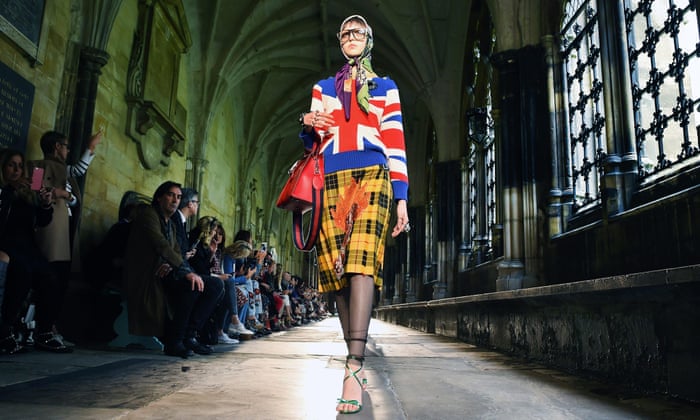
What with hosting 16 royal weddings as well as every coronation since 1066, Westminster Abbey has seen its fair share of extraordinary outfits. The Queen’s 1953 Norman Hartnell coronation gown took a team of nine seamstresses eight months to make. The Duchess of Cambridge’s Alexander McQueen dress was such a closely guarded secret that embroiderers working on it were told the dress was for a costume drama.
But until the first look from Gucci’s 2017 cruise collection appeared on the flagged cloisters, a thousand years of pageantry at the abbey had not included a fashion show, technically speaking.
And it is probably safe to say that until this moment it had not seen the likes of a rainbow-striped sweater with lace inserts, embroidered with a cat sporting a spiked halo of the type seen in early Christian art, teamed with a kilt in the mustard yellow check made famous by Alicia Silverstone in the film Clueless, finished off with lace tights and spike-heel boots with seven silver buckles each.
If Gucci’s creative director, Alessandro Michele, was intimidated by putting his clothes on display a few feet from the Tomb of the Unknown Warrior, under the same roof as the burial place of 17 British monarchs, eight prime ministers, Geoffrey Chaucer and Charles Dickens, it did not show. The presentation was glorious, charming, surreal, and not so much eccentric as completely unhinged. A striped fur coat was worn with a jewelled turban and bleach-splattered jeans; a dressing gown with winkle pickers; a gold straw boater with a cricket jumper and pearl-heeled sandals.
After the show, Michele waxed lyrical about the richly layered inspirations he had found in British culture. “This culture is an unbelievable treasure,” he said backstage, wearing ribbed sport socks with schoolgirl-style Mary Jane sandals.
“I could work for all my life with this inspiration. What I love about the English aesthetic is the contrast, how the contemporary merges with the past. How you can be a punk, but with a cup of tea.”
Michele’s Gucci has a healthy irreverence for aesthetic boundaries. Aristocratic references are mixed with street, while gender is deemed altogether irrelevant. At Westminster Abbey – where politics and religion, art and society have long been intertwined – union jack sweaters rubbed shoulders with tartan ballgowns, and the Queen’s silk headscarves shared catwalk airtime with distinctly Margot Leadbetter flicked-out hair.
There was a mini controversy in the runup to the show when author the Rev Peter Owen-Jones criticised the abbey’s staging of the event, likening it to “selling our soul for a pair of trousers”.
He said of the decision to hire out the abbey to Kering, the luxury group that owns Gucci: “I can think of no other reason the church is doing this other than money, and that confuses what the church should stand for.”
The cloisters have, however, been available for private hire for over a decade, and have hosted many parties including for private equity companies. Owen-Jones, a campaigner against what he sees as the materialistic sympathies of his church, did not explain why it was a catwalk show to which he specifically objected.
An abbey spokesperson said the response to the show had been “overwhelmingly positive”, and described it as “a new and exciting collaboration for us”.
